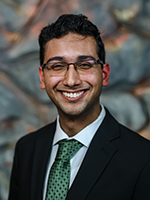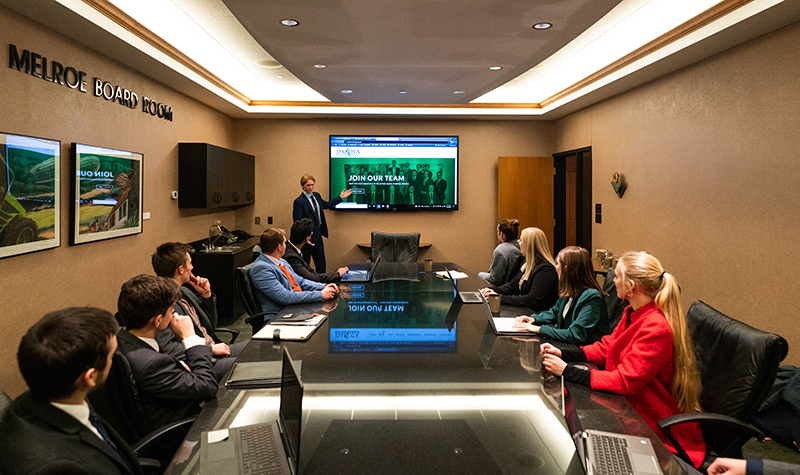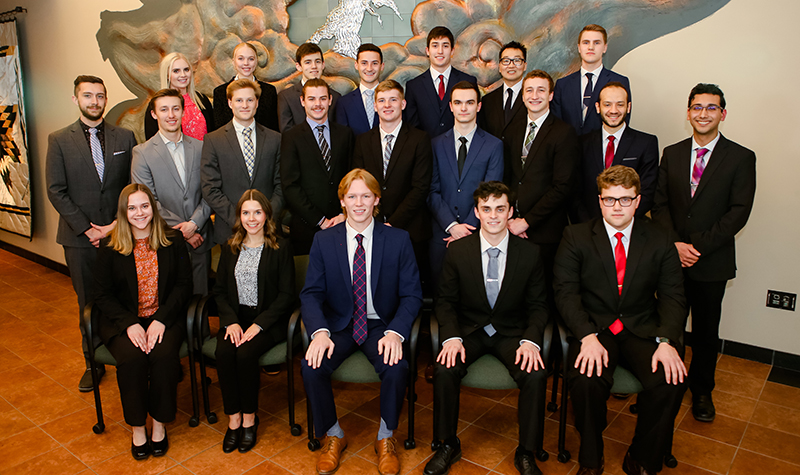New technologies, new ventures for student investors
UND students at Dakota Venture Group set sights higher than ever to make high-tech investments in the region

Last fall, Dakota Venture Group celebrated its 15th anniversary as the nation’s first student-run venture capital firm.
It remains a standout organization in the community and the region, as it gives UND students the chance to invest real money in regional industries and startup companies.
Starting with a $300,000 gift from the Dakota Foundation in 2006, the group steadily has grown its portfolio to include 24 different companies across two separate investment funds.
That’s strong evidence of just how successful the experiment has been. But the 30 or so students making up today’s DVG are doing anything but resting on their laurels.
Today, DVG is in the early stages of raising a third fund — one that will target high-tech industries such as UAS, space, clean energy and artificial intelligence development.

According to Sameer Romani, DVG’s managing director of business development, the idea is to keep the group in a position to support burgeoning industries in the state of North Dakota and beyond.
“As a team of five managing directors, one of our biggest responsibilities is making sure the organization endures to celebrate a 30-year anniversary,” said Romani, a UND senior majoring in aviation management and economics. “We want to contribute to these amazing industries and be part of that ecosystem, as well as give our members a frontline opportunity to work with such companies.”
And the group has a real opportunity to make regional economic impacts in the high-tech sector, said Amy Whitney, director of the Center for Innovation.
“In North Dakota, there is definitely a need for additional investment,” she said. “It will take additional funding avenues like this to grow our technology sector, and this fund represents a way to make that possible.
“Tech-sector industries are a big part of the future, and DVG is preparing to invest in future-facing startup opportunities.”
Harvest Fund II
This new, third fund is known as Harvest Fund II — a sequel to the group’s second fund, which began in 2012. Harvest Fund I focuses its investments in medical, technology and energy industries, according to DVG’s website.
“The first fund, the Innovation Fund, was started in 2006 from donated capital that eventually amounted to $400,000,” Romani said. “For the second fund, the first for-profit fund for DVG, we were able to raise $1.4 million. Harvest Fund II is seeking to go to $10 million.”
By raising the stakes, DVG is raising its ability to finance companies that require higher amounts of capital to operate.
“We want to be able to invest in these industries and make sure our existing investments won’t be diluted,” Romani said. “We want to have a significant seat at the table — being able to have board seats, have a voice in these companies, add value to them, all while offering an enhanced experiential learning opportunity for student members.”

Investments in students as well as businesses
Tessa Frederickson breaks down the nature of venture capital in simple terms. As managing director of marketing, Frederickson’s job is to recruit prospective student members and manage DVG’s public relations.

“I like to think of us as the middleman,” said Frederickson, a junior majoring in marketing and management. “People give us money, then we invest it with the goal of getting a return.”
Romani took an illustrative approach in his own description. “Imagine a box,” he said. “The limited partners, whom we call LPs, put in money as an investment. We then divert that money into all of these portfolio companies in the box. We get to manage where that money goes, then distribute returns.”
In the case of the Innovation Fund, which was started with capital from the Dakota Foundation, returns on the fund’s investments go back to the Dakota Foundation. Harvest Fund I has LPs to which profits return.
For each company in which DVG invests, at least one member of the group — more commonly known as a managing associate — has a responsibility to keep tabs on the company’s progress and make weekly reports to the group’s leadership team. During these weekly meetings, the group also talks about potential new investments and partnerships. Lately, Harvest Fund II is the main topic of conversation.

For Harvest Fund II, the group is laying the groundwork for a multi-year process by which they’ll pitch potential LPs who are looking to invest in those targeted high-tech industries.
“Something we’ve realized when talking to those limited partners and potential investors, through the pandemic and the state of the economy, is that people are looking to diversify their portfolios beyond the traditional stock market or retirement account,” said Georgia Paul, a graduate student and DVG’s lead on the pitch committee.
“DVG can be a way to do that and, hopefully, we get a great return on their investment,” she added. “But they can also feel good about that return, because the investment is going back into the Midwest, back to UND and new students and back to businesses potentially based in Grand Forks and North Dakota.”

Value of a network
Though originally a subsidiary of the Center for Innovation, DVG is now its own 501(c)(3) nonprofit organization, complete with an advisory board of regional business leaders and entrepreneurs with close ties to UND. That said, the group still calls the CFI home. As tenants of the center, DVG has access to the same resources and expertise that other tenant companies and organizations have.
This existing network — between DVG’s board and the CFI ecosystem — is partly what inspired the aims of Harvest Fund II, in addition to the notions of diversifying and elevating DVG’s investment portfolio.
Frederickson talked about the usefulness of these connections in the context of companies approaching DVG for money. As a company pitches its ideas, potential products or services for an investment, executives are going to make their best and most upbeat case.
“They can tell us whatever they want about this company,” said Frederickson in her example. “But if we decide that we might possibly want to make an investment, we do an in-depth report and look at everything about their product.”
In this process of picking apart a pitch, being able to talk to industry leaders and people with a deep knowledge of the particular field is invaluable. By consulting its network, in other words, DVG is able to better determine whether a product is a real innovation.
“DVG is blessed to have an advisory board with diversified backgrounds,” Romani said. “One founded a UAS company that’s based in Grand Forks, another is an active member with the Grand Forks Chamber of Commerce. Others work at UND and have access via research partnerships, such as with the U.S. Space Force.
“We’re able to consult people who are aware of what’s happening in the region, or who know where the next hot company is. By tapping into that network, before you know it, we can have 10 introductions made that week with companies our funds are interested in.”
And as DVG prepares its own pitch — for partners to invest in that $10 million goal for Harvest Fund II — the group’s immediate network plays the same role.
The ideal investors are people or organizations that have connections to UND, believe in experiential learning for students or have ties to the industry in question, Paul said. And DVG’s extensive history, with hundreds of graduates who’ve now been involved, also has created a web of alumni and connections.
“It’s really a unique opportunity and story that we’re trying to sell,” Paul said. “When we pitch those diversified portfolios, we’re showing both a good way to give back as well as invest.”

Experiences well worth the investment
Given that the students who join DVG aren’t able to make a profit themselves, the value they derive comes from the hands-on experience that happens with managing their investments.
Paul said her experience jump-started a career in entrepreneurship and venture capital. DVG provides students with a rare look into those careers, as well as a reason for them to say, “I’ve done this and I want to keep doing it,” she said.
Romani, for his part, agreed that the experience has been well worth the investment of time. He’s been able to create an extensive personal network through his work with directing boards of other companies and partners, as well as at the CFI.

“It’s been amazing, and it’s bittersweet because I need to step away after graduation,” said Romani, who’s graduating this month. “Professors and peers at UND know the value and magnitude of the work you do with DVG, and they see you with a lot of respect as a result.”
And the professors and peers aren’t the only ones. As pointed out by Center for Innovation Director Whitney, the center itself and even the Grand Forks region benefit from DVG. As DVG raises its fund to invest in futuristic technologies, the center gets to highlight a new potential funding opportunity. In combination with the existing tenant structure at the center, the result is a “collaborative cross-pollination” that can diversify the region’s economy.
“There are many shining stars from across campus that are part of the organization,” Whitney remarked. “UND should be proud of the students and alumni who are part of DVG.”



